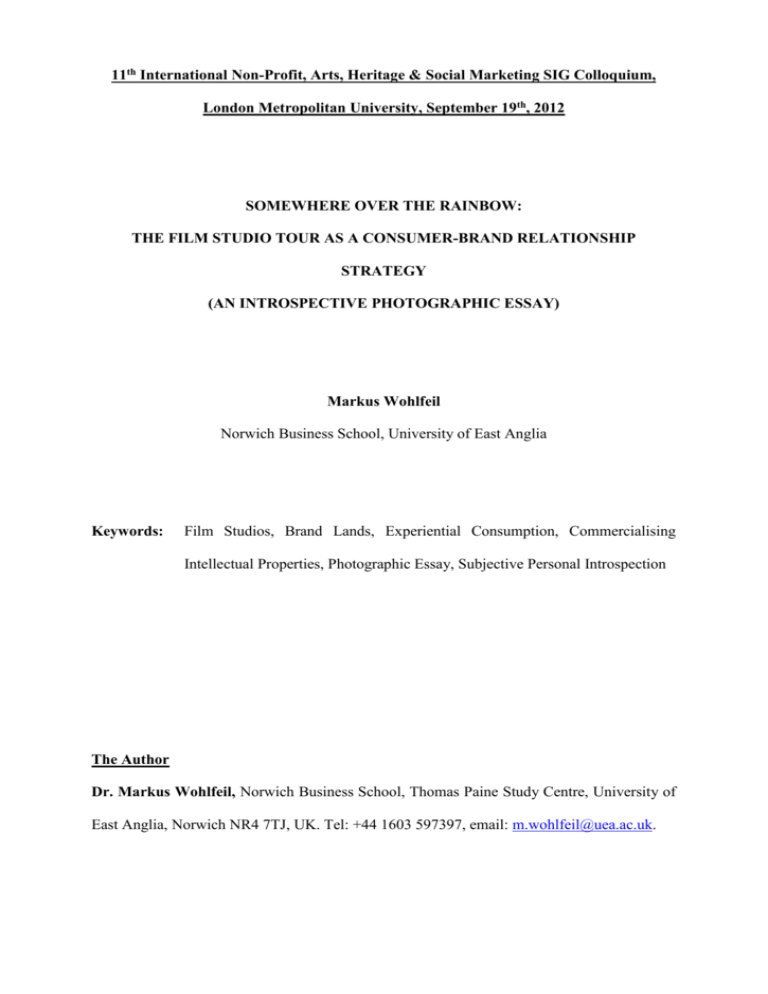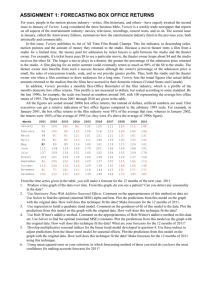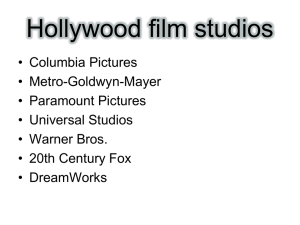- UEA Digital Repository
advertisement

11th International Non-Profit, Arts, Heritage & Social Marketing SIG Colloquium, London Metropolitan University, September 19th, 2012 SOMEWHERE OVER THE RAINBOW: THE FILM STUDIO TOUR AS A CONSUMER-BRAND RELATIONSHIP STRATEGY (AN INTROSPECTIVE PHOTOGRAPHIC ESSAY) Markus Wohlfeil Norwich Business School, University of East Anglia Keywords: Film Studios, Brand Lands, Experiential Consumption, Commercialising Intellectual Properties, Photographic Essay, Subjective Personal Introspection The Author Dr. Markus Wohlfeil, Norwich Business School, Thomas Paine Study Centre, University of East Anglia, Norwich NR4 7TJ, UK. Tel: +44 1603 597397, email: m.wohlfeil@uea.ac.uk. ABSTRACT Ever since the birth of Hollywood in 1912, film studios have catered to a strong consumer demand for entertaining experiences and first-hand insights into the ‘glamorous and magical world of film’ by providing keen film audiences with guided studio tours and film-theme parks (Wohlfeil, 2012, p. 2). But what the film studios once treated only as a peripheral sideshow (Epstein, 2005) to their primary business of producing films is increasingly becoming of vital importance in their overall marketing mix (Blume, 2006). Indeed, as an unprecedented growth in digital piracy is leading to a severe and rapid decline in the important incomes from their traditional auxiliary markets, which include DVD sales and rentals, TV, legal downloads and VoD, film studios across the world are facing once again substantial economic pressures that threaten their very existence (Hennig-Thurau et al., 2007; Waterman et al., 2007; Ochiva, 2006). Hence, one way by which they seek to compensate for this deficit is to cater to the persistently strong consumer demand for entertaining first-hand experiences and insights into the ‘glamorous and magical world of film’ and filmmaking by commercialising their corporate brands and intellectual film properties as film-theme parks or guided studio tours (Blume, 2006; Wohlfeil, 2012). Theme parks are thereby designed to provide consumers with an entertaining audio-visual environment in which the fictional worlds of film texts (narrative plots, characters, props and settings) are recreated as appropriately themed sceneries, rides, restaurants and shops, while guided studio tours offer visitors informative insights into the art of filmmaking and the industrial film production process of a working film studio. However, while approximately 90 million people in total flock each year to the various filmtheme park resorts set up by Disney Corp., Universal Studios and other film studios across the world (TEA/AECOM, 2010), no reliable figures are currently available with regard to studio tours – although it is only fair to assume that they are much lower. Indeed, Wohlfeil (2012) found that studio tours of working film studios tend to appeal to smaller target audiences and 2 are often restricted to limited visitor numbers. Thus, if the primary aim for commercialising intellectual film properties as entertaining brand land experiences is to generate additional revenues and to compensate for the loss of income from other sources, then – by virtue of sheer volume in terms of visitor numbers and revenues – theme parks have proven to be quite clearly a much more efficient and profitable option for film studios. But many international film studios such as Warner Brothers, Paramount Studios, Columbia TriStar or Babelsberg Studios still continue to offer instead guided studio tours to interested film audiences. This, therefore, leads to an interesting question that warrants further investigation: What role do studio tours these days play within the marketing mix of film studios? The answer may lie in the historical origins of the studio tour, which the Hollywood film studios initially introduced as a tactical response to the substantial social and political pressures they came under from influential social reformers like the Christian Temperance Union and the subsequent Hayes Commission (Barbas, 2001; Thorp, 1939). However, Jack Warner, Samuel Goldwyn, Irving Thalberg, David O. Selznick and other studio executives of the Hollywood studio era also saw the studio tour an essential tool in having “a close ear to the pulse and voice of the audience” (Barbas, 2001, p. 139) and to build strong emotional bonds between consumers and the studio brand long before relationship marketing became a buzz word in modern marketing literature (Epstein, 2005). But the question remains as to what extent studio tours are still adhering to this ideal and what role they are playing in a film studio’s relationship marketing strategy? In this study, hence, I take a closer look at how Hollywood studios provide consumers during their guided studio tours with the (controlled) opportunity to obtain first-hand insights into the imaginative, creative and industrial world of filmmaking and, thereby, try to foster consumerbrand relationships. In doing so, this study follows up on some of the themes that emerged in Wohlfeil (2012) and explores them further. Personally, I have since my early childhood been fascinated by the magical world of films that I enjoy watching for their aesthetic and hedonic 3 pleasure value (Wohlfeil & Whelan, 2008, 2012). My fascination with films, however, also includes a keen interest in the film industry and the art of filmmaking. And as studio tours allow me to see and experience the film production process in person and on location, I had the opportunity to take the guided studio tours at the Warner Brothers Studios in Burbank and the Paramount Studios in Hollywood as a ‘genuine’ visitor during a weeklong vacation in Los Angeles – as opposed to a researcher driven by a defined research agenda – and captured my impressions in a series of photographs. Nonetheless, these private visits also provide a unique opportunity to gain some real holistic insights into the studio tour experience from an actual consumer’s point of view, which is only too often ignored in quantitative and critical research. Therefore, based on my personal experiences, observations and participatory interactions with other visitors and staff members at these two Hollywood film studios, I use a photographic essay approach (Holbrook, 2005; Houston & Meamber, 2011; Wohlfeil, 2012) to explore what inherent consumer needs and desires film studios are catering to with their studio tours and how consumers actually experience and engage with them. Even though the time spent at each research site and the freedom to take photos varied between the two studios for various reasons, I recorded my experiences, observations and conversations with other visitors and staff members during each of the two visits in a series of photographs (40 at Warner Brothers and 61 at Paramount) and as field notes in a reflective diary (Wohlfeil & Whelan, 2012). Both the photos and the field notes were analysed hermeneutically by taking an ‘I’m-the-camera’perspective (Holbrook, 1998, 2006), which holds that photographs not only provide objective proof of the observed, but also are a mode of introspective self-expression that visualises the subjective experience of the observer. Supported by a selected photo sample, the photographic essay presents the findings that emerged iteratively from their hermeneutic interpretation. So, what can we take away from the introspective photographic essay? Well, the data clearly suggest that the role of guided studio tours within the marketing mix of film studios must in 4 fact be described as unclear, ambiguous and underutilised. As both film studios barely charge $20 per ticket, demand pre-booking and restrict visitor numbers in order not to disrupt film production, it seems that they don’t really see guided studio tours, unlike film-theme parks, as a ‘money-spinning device’ after all. Instead, Warner Brothers are increasingly availing of their studio tour as a means of re-engaging with the public. For Paramount executives, on the other hand, the studio tour appears to be little more than a historic legacy with no further strategic value that they are obliged to carry on. This is quite unfortunate, as the photographic essay forcefully highlights the untapped marketing potential for fostering valuable consumer-film studio relationships that guided studio tours still offer these days – just like they did in the heydays of the Hollywood studio system (Barbas, 2001; Epstein, 2005). Indeed, unlike their (artificial) counterparts in film-theme parks like the Universal Studios resorts, which closely follow a fixed and well-rehearsed script with little more than another entertaining ride through the glamorous world of Hollywood film texts (Wohlfeil, 2012), the guided studio tours at both Warner Brothers and Paramount offer consumers informative first-hand insights into the industrial realities of the film production process. In small groups, visitors are thereby shown around the actual film sets, soundstages, backlots and any other interesting technical facilities by a knowledgeable employee in an interactive, flexible and personalised manner that feels genuine and authentic. Therefore, it comes to no surprise that consumers take these studio tours because they know that the working studio they are visiting is the real deal – and not just a mere representation of a film studio. Moreover, the photographic essay clearly shows that guided studio tours appeal in particular to those consumers with a keen interest in the art and craft of filmmaking, who not only seek genuine informative insights into the film business, but often also have some practical experiences in amateur or hobby filmmaking. Apart from the fact that many fellow visitors in my tour groups carried semi-professional camcorders or DSLR-cameras with them, 5 the interactive and personalised nature of both observed studio tours also encouraged visitors to share their personal experiences with (semi-)professional (digital) film equipment, such as specific camcorder models and editing software, and filmmaking with each other and the tour guide. In light of this highly interested and potentially loyal audience, this study has found it quite astonishing that both film studios make no effort in availing of the provided marketing opportunities for proper strategic relationship marketing. For instance, by maintaining an ongoing dialogue with these consumers beyond their visit and creating a brand community for amateur/hobby filmmakers around their studio brand, a film studio would be able to benefit in many ways from a symbiotic relationship with a loyal consumer segment. In a similar vein, the photographic essay also finds that providing consumers with a complementary photo of their experience with a bluescreen or special effects helps to strengthen the visitor experience and their emotional bond to the film studio. As done by Warner Brothers, film studios are also well-advised to offer consumers the opportunity to purchase studio-branded merchandise such as T-shirts, sweatshirts, caps, mugs and other collectibles in a publicly accessible and wellstocked store. While this last point may seem only too obvious, the collected introspective data from the Paramount Studios clearly prove that, actually, this is still not always the case. References Barbas, S. (2001). Movie Crazy: Fans, Stars and the Cult of Celebrity. New York: Palgrave. Blume, S. E. (2006). The Revenue Streams: An Overview. In J.E. Squire (Ed.), The Movie Business Book: International 3rd Edition (pp. 332-359). Maidenhead: McGraw-Hill. Epstein, Edward J. (2005), The Big Picture: Money and Power in Hollywood. New York: Random House. Hennig-Thurau, T., Henning, V. & Sattler, H. (2007). Consumer File Sharing of Motion Pictures. Journal of Marketing, 71(1), 1-18. 6 Holbrook, M. B. (1998). Journey to Kroywen: An Ethnoscopic Auto-Auto-Auto-Driven Stereographic Photo Essay. In B. B. Stern (Ed.), Representing Consumers: Voices, Views and Visions (pp. 231-263). London: Routledge. Holbrook, M.B. (2005). Customer Value and Autoethnography: Subjective Personal Introspection and the Meanings of a Photograph Collection. Journal of Business Research, 58 (1), 45-61. Holbrook, M. B. (2006). Photo Essays and the Mining of Minutiae in Consumer Research: ‘Bout Time I Got to Phoenix’. In R. W. Belk (Ed.), Handbook of Qualitative Research Methods in Marketing (pp. 476-493). Cheltenham: Edward Elgar Publishing. Houston, H. R. & Meamber, L. A. (2011). Consuming the “World”: Reflexivity, Aesthetics and Authenticity at Disney World’s EPCOT Center. Consumption, Markets and Culture, 14(2), 177-191. Ochiva, D. (2006). Entertainment Technologies: Past, Present and Future. In J.E. Squire (Ed.), The Movie Business Book: International 3rd Edition (pp. 498-529). Maidenhead: McGrawHill. TEA/AECOM (2010), 2010 Theme Index: The Global Attractions Attendance Report, Burbank, California: Themed Entertainment Association. Thorp, M. (1939). America at the Movies. New Haven: Yale Press. Waterman, D., Ji S. W. & Rochet, L. R. (2007). Enforcement and Control of Piracy, Copying and Sharing in the Movie Industry. Review of Industrial Organization, 30, 255-289. Wohlfeil, M. (2012). Between Entertainment and Authenticity: The Film Studio as a Brand Land Experience (An Introspective Photographic Essay). Proceedings of the 2012 Academy of Marketing Annual Conference at the University of Southampton, Southampton: Academy of Marketing, on USB. 7 Wohlfeil, M. & Whelan, S. (2008). Confessions of a Movie-Fan: Introspection into a Consumer’s Experiential Consumption of ‘Pride & Prejudice’. European Advances in Consumer Research, 8, 137-143. Wohlfeil, M. & Whelan, S. (2012). ‘Saved!’ by Jena Malone: An Introspective Study of a Consumer’s Fan Relationship with a Film Actress. Journal of Business Research, 65(4), 511-519. 8




![[Lecture 19] studio system 2 for wiki](http://s2.studylib.net/store/data/005217793_1-c296c1b3b7b87d52a223478e417a702f-300x300.png)


